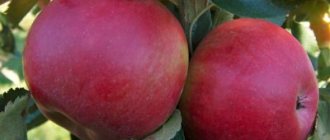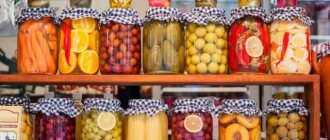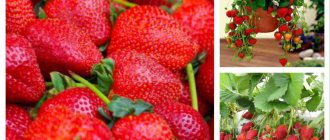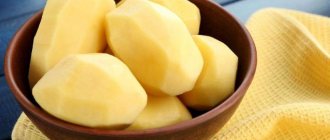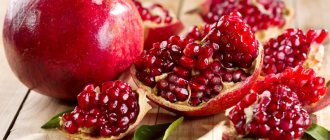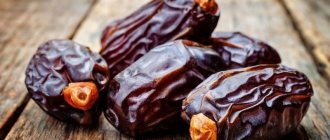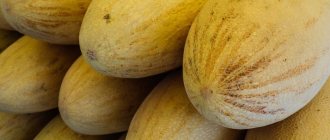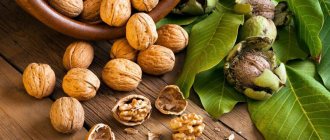The shelf life of tomatoes depends on many factors. This includes competent agricultural technology for growing plants throughout the season, and correct timely collection of fruits, and their subsequent sorting by size and degree of ripeness, and choice of location, and compliance with optimal conditions during storage (temperature, humidity, etc.).
And, of course, the initial choice of variety is very important - it’s no secret that different tomatoes differ markedly in this regard. For long-term storage, fleshy tomatoes with thick, smooth skin and medium-late and late ripening are better suited. Some of these tomatoes, if all storage conditions are met, can be kept fresh not only until the New Year, but almost all winter!
On the bushes of such tomatoes, only single fruits usually ripen (a special gene for “long ripening” is responsible for this). And before frost they are harvested unripe, green - the main part ripens during storage.
In many of these tomatoes, the “external” ripening, which many determine by the change in color to “ripe,” has nothing to do with the “internal” ripening. The seed chambers containing the contents of such tomatoes ripen much earlier than the fruit itself. Therefore, the seeds may well germinate directly in it.
The only serious disadvantage is that such tomatoes generally do not have a bright sweet taste, but rather have a rather average, “fresh” taste without an abundance of sugars and acids. However, as the proverb says, there is no friend according to taste. So, if you are interested in long-lasting tomatoes, pay attention to the following proven varieties.
Tomato New Year's
A variety of Russian selection, late ripening.
In the middle zone it is recommended for cultivation in greenhouses; in the southern regions it can be cultivated in open ground.
The plant is of medium size (above 1.5 m), indeterminate type, requires pinching and tying to a trellis. It is recommended to form this tomato into one stem.
The variety is unpretentious in cultivation, resistant to fusarium, tobacco mosaic, and cladosporiosis. Productivity – up to 3.5 kg per bush.
The fruits are flat-round in shape, medium in size (150-170 g), yellow-orange in color when fully ripe. Fruits should be collected and stored in a state of technical ripeness - green in color. The skin is smooth, dense, resistant to cracking, the flesh is pink, quite dense and juicy, crispy, of medium taste.
The fruits are well transported and have one of the longest shelf lives of similar varieties - up to March. Recommended for canning and processing.
Tomato Ozaltin red/yellow
The variety is high-yielding, late-ripening.
In the middle zone it is recommended for cultivation in greenhouses; in the southern regions it can be cultivated in open ground.
The plant is powerful, tall (above 1.8 m), indeterminate type, but not spreading, requires pinching and tying to a trellis. It is recommended to form this tomato into one or two stems.
The variety is unpretentious in cultivation and resistant to many diseases. Productivity – 4-5 kg per bush.
The fruits ripen in clusters, round-oval in shape, small and medium in size (60-110 g), leveled, red-orange in color when fully ripe (there is a yellow-fruited form of the variety). The skin is smooth, dense, the flesh is rich red, juicy, fleshy, with a good sweet and sour taste.
The fruits are easily transported and have a long shelf life. Recommended for fresh consumption, canning and processing.
Recommended conditions
To ensure lying down, it is necessary to create suitable conditions, because their duration will depend on them. Important for storage:
- Compliance with recommended temperature and humidity levels. The maximum upper temperature threshold should not exceed +22 degrees, and the lower - +10 degrees. Room humidity is 70-80%.
- Lack of light in the room, as it stimulates overripening of vegetables, which leads to their drying out and rotting. If brown specimens are still planted, then the presence of sunlight or artificial lighting is allowed for them, but only for the ripening period.
- Choose the most convenient container, which can be ordinary wooden boxes, wicker baskets and boxes. If you plan to store them in cardboard boxes, then you must first make vent holes in them for full circulation of fresh air.
- Use additional materials to maintain the required microclimate in the container. For this purpose, they are sprinkled with sawdust, peat, straw, or wrapped in thin paper. If one specimen rots, the others will remain uninfected.
Once or twice a week, it is recommended to check the harvested crop for spoiled fruits, and also change the tomatoes. Quite often, infection with late blight and bacterial cancer is detected, as indicated by the appearance of brown spots. Sick tomatoes must be removed from the box as quickly as possible.
The optimal place for storing tomatoes is the basement, but if it is not available, storage can be arranged on an insulated balcony, pantry, or even under the bed, but only if there are no heating radiators nearby. If desired, ripe vegetables can be placed in the refrigerator, but in this case their shelf life will be much shorter.
Tomato Long Keeper
A variety of Soviet selection, high-yielding, late-ripening.
In the middle zone it is recommended for cultivation in greenhouses; in the southern regions it can be cultivated in open ground.
The plant is powerful, medium-sized (up to 1.4 m), determinate type, requires tying to a trellis, pinching is not necessary. It is recommended to form this tomato into one or two stems.
The variety is unpretentious in cultivation, resistant to fusarium, tobacco mosaic, and cladosporiosis. Productivity is about 6 kg per bush. The fruits, having reached full ripeness on the bush, may begin to crumble.
The fruits ripen in clusters, flat-round in shape, medium to large in size (150-300 g), and light pearl-orange in color when fully ripe. Fruits should be collected and stored in a state of technical ripeness - whitish-green in color. The skin is smooth, dense, the flesh is very dense, red-pink in color, good sweet taste with a slightly noticeable sourness.
The fruits are easily transported and have a very long shelf life - up to February-March. Recommended for fresh consumption, canning and processing.
Collection and preparation rules
For long-term storage, it is important to harvest the crop correctly, because in some cases this factor turns out to be decisive. The risk of damage will be reduced to a minimum if:
- The harvest is harvested before the night temperature drops below +8 degrees. The fact is that specimens exposed to lower temperatures will quickly rot and become stained.
- It is recommended to pick the fruits in the daytime after the dew has completely disappeared - wet tomatoes begin to rot in record time.
- Do not forcibly tear off the stalk, as this leads to the formation of microdamages, which cause rapid spoilage of the vegetable.
Before planting the crop, it must be properly prepared, namely:
- Carefully sort through, dividing into ripe and brown, whole and damaged, large, medium and small. The resulting categories should never be mixed, as this will lead to their rapid spoilage.
- Check for dryness, as even a few drops of moisture can cause irreparable harm.
Pre-treatment of each specimen with alcohol, a weak solution of gelatin, potassium permanganate or boric acid will help to extend the shelf life. After wiping, the crop should be thoroughly dried and only then stored in boxes. In a container, tomatoes should be stacked with the stems facing down, as this part is more sensitive to damage. It is not recommended to lay more than two layers, as this will inevitably damage their integrity.
Tomato Long-lasting
A variety of Russian selection, mid-late.
In the middle zone it is recommended for cultivation in greenhouses; in the southern regions it can be cultivated in open ground.
The plant is powerful, tall (above 1.5 m), semi-determinate type, requires pinching and tying to a trellis.
The variety is unpretentious in cultivation. Productivity – 4-5 kg per bush.
The fruits are flat-round, slightly ribbed, medium in size (90-150 g), and rich orange-yellow in color when fully ripe. Fruits should be collected and stored in a state of technical ripeness - green in color. The skin is smooth, dense, the pulp is very dense, orange-red in color, and has a satisfactory taste.
The fruits are easily transported and have a very long shelf life - up to February-March. Recommended for fresh consumption, canning and processing.
Tomato Snowfall F1
Hybrid of Russian selection, mid-season.
In the middle zone it is recommended for cultivation in greenhouses; in the southern regions it can be cultivated in open ground.
The plant is powerful, tall (up to 2 m), branched, indeterminate type, requires pinching and tying to a trellis. It is recommended to form this tomato into two stems.
The hybrid is unpretentious in cultivation, very cold-resistant, resistant to tobacco mosaic, and is slightly affected by anthracnose and alternaria. Characterized by an extended ripening period. Productivity – up to 4-4.5 kg per bush.
The fruits ripen in clusters, round-oval in shape, slightly ribbed towards the stalk, medium in size (100-130 g), leveled, light bright red in color when fully ripe. The skin is smooth, glossy, dense, does not crack, the flesh is aromatic, dense, red, of good taste.
The fruits are easily transported and have a long shelf life. Recommended for fresh consumption, canning and processing.
Tomato Giraffe
A variety of Russian selection, late ripening.
In the middle zone it is recommended for cultivation in greenhouses; in the southern regions it can be cultivated in open ground.
The plant is powerful, tall (above 2 m), semi-determinate type, requires pinching and tying to a trellis. It is recommended to form this tomato into one stem.
The variety is unpretentious in cultivation, resistant to brown spot, tobacco mosaic, and brown rot. Productivity – up to 3-4 kg per bush.
The fruits are round-oval, small to medium in size (60-130 g), light golden-orange in color when fully ripe. Fruits should be collected and stored in a state of technical ripeness - green in color. The skin is smooth, dense, the flesh is quite dense, with a small number of seeds, can be pink in color, and has an average taste.
The fruits are well transported and have one of the longest shelf lives of similar varieties - up to March. Recommended for canning and processing.
Rules for storing fresh crops
Harvested and sorted tomato crops with a long shelf life are provided with conditions under which ripening occurs for as long as possible. To do this, they are placed in a cool place away from apples, bananas and other fruits that emit ethylene. The presence or absence of lighting does not play a significant role. At home, you can store green tomatoes on a shelf in the refrigerator, in the cellar or in glass jars. Each option has its own subtleties.
In a refrigerator
A small number of tomatoes can be placed in the vegetable compartment of the refrigerator for ripening. It is convenient to store the harvest of cocktail varieties or cherry tomatoes. Before planting, it is advisable to wipe each tomato with a napkin and turn the cuttings up. Every day you should ventilate the shelf with tomatoes and sort out brown or reddened specimens. They release ethylene, which speeds up ripening. You can isolate the fruits from each other using individual paper packaging. Fully ripened tomatoes will retain their quality for no more than a week.
On a note! It is not recommended to store vegetables in a plastic bag. In this form, oxygen access is difficult and conditions are created for high humidity, which provokes rotting.
In the cellar or basement
The optimal solution for preserving the harvest is a cool cellar. The room temperature should be 8-15 °C. The higher it is, the sooner the tomatoes ripen. The collected tomatoes are laid out in wooden boxes in several layers (optimally 2-3). To avoid condensation accumulation, lay them out in layers of paper, newspapers or sawdust.
An important storage condition is periodic ventilation. This procedure is combined with a harvest audit. Ripe tomatoes, which begin to change color earlier than others, are transferred to a separate container. Remove specimens with signs of rotting or other damage. In a basement or cellar, the harvest can be stored for several months, depending on the variety.
In banks
Another way to preserve fresh tomatoes is to put them in glass jars. To do this, wipe the vegetables with a cotton swab soaked in alcohol (can be replaced with vodka), dry them, and place them in a sterilized container. There are several popular methods:
